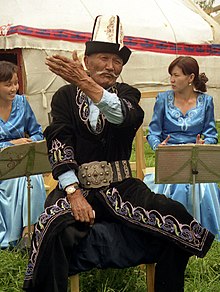Tradhisi lésan

Tradhisi lésan utawa kawruh lésan iku wujud sesambunganing manungsa kang minangka sarana nampa, ngurip-urip, lan nularaké kawruh, kagunan, lan gagasan saka siji génerasi marang génerasi liyané.[1][2][3] Anggoné nularaké kanthi sarana guneman utawa lelagon kang bisa wujud carita, parikan, tembang, utawa suluk. Kanthi cara iki, bebrayan agung bisa nularaké babad, sastra, pranata, lan kawruh liyané sarana lésan saka siji génerasi marang génerasi liyané sanajan tanpa sarana aksara, nanging isih saèmper aksara. Agama kaya ta Buda, Indhu, lan Jain nganggo tradhisi lésan, mbarengi panganggoning aksara, saperlu nularaké kitab-kitab agama, kawruh kabuwanan kaya ta Sushruta Samhita, tetembangan lan carita rakyat kanthi ngambahi sawatara génerasi.[4][5]
Tradhisi lésan iku sesurupan, éling-élingan, lan kawruh kang diduwèni bebarengan wong sagolongan saka pirang-pirang génerasi, lan ora padha karo paseksèn (testimony) utawa babad lésan (oral history).[6][7] Tegesé kang lumrah, "tradhisi lésan" iku pangéling-éling lan caraning nularaké kawruh kabudayan kang kaéling-éling mau ing tembung baka tembung kanthi sarana lésan.[8] Minangka dhisiplin akadhemis, tradhisi lésan minangka saprangkat obyèk kang kasinau lan caraning nyinau obyèk-obyèk mau.[9]
Studhi ing tradhisi lésan iku ora padha karo dhisiplin akadhemis bab babad lésan,[10] ya iku cathetan éling-élingan lan babad sawongan kang ngalami mangsa lan lelakon sajarah.[11] Tradhisi lésan uga ora padha karo studhi kalésanan (orality) kang tegesé pikiran lan caraning medaraké pikiran mau ing bebrayan agung kang pérangan gedhéning wargané durung wanuh tèhnologi literasi (mligi tulisan lan cap-capan).[12] Carita rakyat (folklor) iku salah siji jinising tradhisi lésan, sanajan uga ana kawruh sajabaning carita rakyat kang tinularaké sarana lésan lan mula lestari.[13][14]
Rujukan
- ↑ Vansina, Jan: Oral Tradition as History (1985), reported statements from present generation which "specifies that the message must be oral statements spoken, sung or called out on musical instruments only"; "There must be transmission by word of mouth over at least a generation". He points out, "Our definition is a working definition for the use of historians. Sociologists, linguists or scholars of the verbal arts propose their own, which in, e.g., sociology, stresses common knowledge. In linguistics, features that distinguish the language from common dialogue (linguists), and in the verbal arts features of form and content that define art (folklorists)."
- ↑ Oral Tradition Archived 2016-08-09 at the Wayback Machine., Encyclopædia Britannica, John Miles Foley
- ↑ Ki-Zerbo, Joseph: "Methodology and African Prehistory", 1990, UNESCO International Scientific Committee for the Drafting of a General History of Africa; James Currey Publishers, ISBN 0-85255-091-X, 9780852550915; see Ch. 7; "Oral tradition and its methodology" at pages 54-61; at page 54: "Oral tradition may be defined as being a testimony transmitted verbally from one generation to another. Its special characteristics are that it is verbal and the manner in which it is transmitted."
- ↑ Jack Goody (1987). The Interface Between the Written and the Oral. Cambridge University Press. kc. 110–121. ISBN 978-0-521-33794-6.
- ↑ Donald S. Lopez Jr. (1995). "Authority and Orality in the Mahāyāna". Numen. Brill Academic. 42 (1): 21–47. doi:10.1163/1568527952598800. JSTOR 3270278.
- ↑ Vansina, Jan: Oral Tradition as History (1985), reported statements from present generation which "specifies that the message must be oral statements spoken, sung or called out on musical instruments only"; "There must be transmission by word of mouth over at least a generation". He points out, "Our definition is a working definition for the use of historians. Sociologists, linguists or scholars of the verbal arts propose their own, which in, e.g., sociology, stresses common knowledge. In linguistics, features that distinguish the language from common dialogue (linguists), and in the verbal arts features of form and content that define art (folklorists)."
- ↑ Henige, David. "Oral, but Oral What? The Nomenclatures of Orality and Their Implications" Oral Tradition, 3/1-2 (1988): 229-38. p 232; Henige cites Jan Vansina (1985). Oral tradition as history. Madison, Wisconsin: University of Wisconsin Press
- ↑ Oral Tradition Archived 2016-08-09 at the Wayback Machine., Encyclopædia Britannica, John Miles Foley
- ↑ Dundes, Alan, "Editor's Introduction" to The Theory of Oral Composition, John Miles Foley. Bloomington, IUP, 1988, pp. ix-xii
- ↑ Henige, David. "Oral, but Oral What? The Nomenclatures of Orality and Their Implications" Oral Tradition, 3/1-2 (1988): 229-38. p 232; Henige cites Jan Vansina (1985). Oral tradition as history. Madison, Wisconsin: University of Wisconsin Press
- ↑ Oral History Archived August 20, 2011, at the Wayback Machine.
- ↑ Ong, Walter, S.J., Orality and Literacy: The Technologizing of the Word. London: Methuen, 1982 p 12
- ↑ Degh, Linda. American Folklore and the Mass Media. Bloomington: IUP, 1994, p. 31
- ↑ Folklore in the Oral Tradition, Fairytales, Fables and Folk-legend Archived 2016-07-19 at the Wayback Machine., Julie Carthy (1984), The Oral Tradition, Volume IV, Yale University, Quote: "Folklore is said to be in the oral tradition. Dundes states that the most common criterion for a definition of folklore is its means of transmission that is, orally. He clarifies however that materials other than folklore are also orally conveyed. Therefore oral transmission itself is not sufficient to distinguish folklore from non-folklore."